Rimless Scales on Lepidote-Non-lepidote Hybrids
Alexander C. Martin, Los Gatos, California
Because just one lepidote-elepidote hybrid, 'Grierdal', has been recognized in about 150 years of rhododendron breeding, my report on 24 such crosses, plus 3 lepidote-azalea combinations, will need more than mere assertion and faith. That's why the focus will be primarily on tiny leaf outgrowth of the kind that helped validate the unprecedented parentage of 'Grierdal', nearly a quarter-century ago.
1
The term non-lepidote will be used here to embrace elepidote rhododendrons and azaleas; generally the designation elepidote excludes azaleas.
I am indebted to George M. Cunningham for skillful, generous cooperation in the photography. Also, the Maurice H. Sumners, the Edward H. Longs, Charlotte Kenna, and other friends helped by allowing me to hybridize on their plants or by making pollen available.
The Diagnostic Structures
What to call the curious little objects on lepidote-non-lepidote leaves is somewhat of a problem; they look like compromises between scales and hairs, and probably are just that, as suggested by Dr. Cowan.
2
In describing this sort of pseudo-scale on 'Grierdal', he stated: "Instead of appearing on surface view as a flat plate or shield, the scale appears as a compactly rounded head." That's exactly the way they look on my hybrids: tiny, roundish globules, with no marginal rim or brim (Fig. 47). And that's why the name rimless scale is used here.
An additional distinction that was noted between normal scales of lepidotes and the rimless type of scale on 'Grierdal' was the elongated stalk of the latter. In Miss Waterston's words: "...an abnormally large stalk." Many of my hybrids also have long stalked rimless scales, and many do not; it's an inconsistent feature, varying from cross to cross or plant to plant.
On some of the hybrids, the stalks of rimless scales are so short that instead of extending out of the shallow depressions in which they occur, they are hidden under the scale head, as Dr. Cowan has indicated is typical for normal scales.
3
However, visible stalks are present on many of the scales of hybrids. When seen in profile, as along leaf margins, rimless scales resemble fairy goblets of a solidified sort, some without evident supports and others with short, medium, or tall stems (Fig. 44).
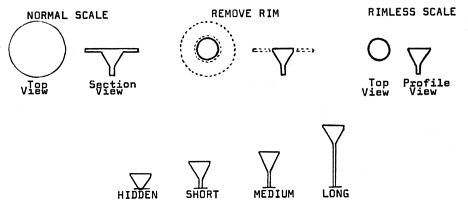
|
|
Fig. 44. Above: Diagram contrasting normal scales with
rimless ones. Below: Variation of stalks of rimless scales. |
Hand-lens examination of all the hybrid seedlings (about 125), accompanied by sketches and notes for each lot, disclosed surprisingly consistent similarity in the rimless scales throughout, regardless of whether the seed parent was lepidote or non-lepidote. This uniformity was particularly evident in: (1) the absence of a rim on all the scale-like structures-without a single exception; (2) consequent substantial reduction in scale-head size: (3) the solid-goblet profile outline. The scale-head diameter seemed about equivalent in all instances, though it may be slightly greater in examples with hidden stalks.
Because of this uniformity, macro-photographs of rimless scales on all 27 of the hybrid lots would have been monotonously repetitious and doubtfully justified. Consequently, representative examples are shown instead in Fig. 47.
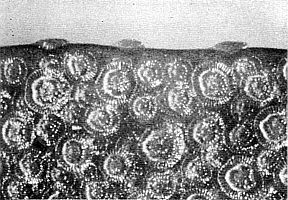
|
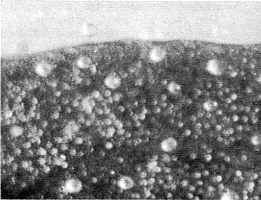
|
| Fig. 46. Normal scales of R. carolinianum |
Fig. 47. Rimless scales of
R.
carolinianum x 'Goldbug'. |
Besides variation in stalk length, already discussed, there is considerable diversity in abundance or scarcity of the tiny, rimless structures themselves. When the leaf has a coat of hairs and the scales are few and far between, they are sometimes difficult to locate. A lush specimen of 'King of Shrubs' x 'Forsterianum', additional to the one shown in Fig. 48, was temporarily "written off" as apomyctic until closer scrutiny disclosed a few rimless scales among somewhat similar glandular hairs. On the somewhat hairy leaves of 'Vulcan' x R. bullatum seedlings, the structures are also sparse and not easily found. The smallest of the three R. carolinianum x 'Elizabeth' seedlings is a strange maverick that shows no scales at all.
A Summary of Lepidote-non-lepidote Clues
Study of the hybrids has yielded the following clues that seem to point to lepidote-non-lepidote ancestry:
- Presence of rimless, globular or goblet-shaped, scale-like structures;
- That are considerably smaller than normal scales;
- And are distributed more sparsely over the leaf surface;
- And often have stalks long enough to be visible, whereas the short stalks of normal scales are always hidden;
- Rimless scales on plants from non-lepidote seed parents would seem to be especially conclusive evidence;
- It also appears significant when, as in my numerous seedlings from crosses onto R. carolinianum , lots from different pollen parents display obvious dissimilarities in the shape, size, color, texture, and pubescence of leaves, as well as in the color of petioles and stems.
In 1959 lepidote-non-lepidote hybridizing was added to my exploratory projects, when four such crosses were tried but all failed. In the three following seasons, positive results were obtained from total attempts as follows: 1960: 3 out of 18; 1961: 9 out of 91; 1962: 15 out of 82.
In the following listing, the final figures (in parentheses) denote the number of seedlings in each lot. 1962 entries are preceded by numerals that correspond to those in Fig. 48.
| - 1960 - | - 1962 - |
| 'Goldsworth Orange' x 'Forsterianum' (2) | 1. 'Goldfort' x R. davidsonianum (9) |
| 'King of Shrubs' x 'Forsterianum' (2) | 2. 'Brickdust' x R. veitchianum (9) |
| 'Margaret Dunn' x 'Forsterianum' (3) | 3. R. carolinianum x 'Elizabeth' (3) |
| - 1961 - | 4. R. carolinianum x 'Goldsworth Orange' (3) |
| 'Cornubia' x 'Forsterianum' (1) | 5. R. carolinianum x 'Little Pudding' (5) |
|
'Corona' x
R. bullatum
(1)
'Elizabeth' x 'Forsterianum' (3) |
6. R. carolinianum x 'Roseum Elegans' (8) |
| R. keleticum x 'Gumpo' (1) | 7. 'Little Pudding' x R. davidsonianum (1) |
| 'Ruby Bowman' x R. bullatum (8) | 8. 'America' x R. davidsonianum (1) |
| 'Unique' x R. bullatum (1) | 9. R. carolinianum x 'John Waterer' (1) |
| 'Vulcan' x R. bullatum (7) | 10. R. carolinianum x 'Blue Peter' (1) |
| 'Vulcan' x R. burmanicum (1) | 11. R. carolinianum x 'Ruby Bowman' (13) |
| 'Vulcan's Flame' x R. johnstoneanum (1) | 12. R. carolinianum x R. ponticum (17) |
|
13.
R. carolinianum
x 'Goldbug' (3),
and reciprocal (10) |
|
| 14. R. carolinianum x 'Gumpo' (9) | |
| 15. R. carolinianum x Exbury azalea (1) | |
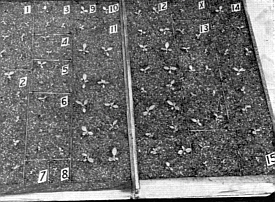
|
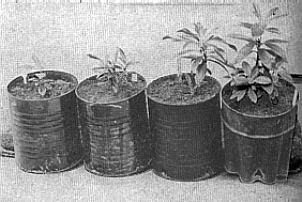
|
|
Fig. 45. 1962 seedlings, 4 months
old, lots identified by numerals that correspond to those in the 1962 listing above. |
Fig. 48. Seedlings selected from the 1960,
1961 crops. Left to right, 'Vulcan' x R. bullatum . 1961; 'Goldsworth Orange' x 'Forsterianum', 1960; 'Margaret Dunn' x 'Foresterianum', 1960; 'King of Shrubs' x 'Foresterianum' |
Seedling Health
Vigor of the plants varied greatly in the different lots and years. In the three successive seasons of 1960-62, crop vigor averaged: fairly good, poor, and very good, respectively. More specifically, the three 1960 crosses, all involving 'Forsterianum' pollen, are fair to excellent and some are likely to bloom in 1964.
The 1961 results were, on the whole poor, with puny, weak seedlings, except for the fairly vigorous 'Vulcan' x
R. bullatum
cross. Some of the weakest of this year will probably be discarded within another year or so.
On the other hand, most of the 1962 seedlings are robust-so much so that many of them are already larger than typical 1961 plants. Vigor of the 1962 crop can be judged to some extent by comparing them with plant "X" in Fig. 45, an average seedling of the same age (four months) from a
R. carolinianum
x
R. bullatum
batch of seedlings. Because of thriftiness of seedlings having
R. carolinianum
as the seed parent (as the pollen parent it wasn't nearly so successful), I have made 41 additional crosses onto it this spring and many of the capsules are swelling encouragingly.
Method Used
What is the magic formula? Naturally there isn't any. For that matter, if my methods do differ substantially from those of fellow breeders who try wide crosses, it would be difficult to know in what particulars divergence exists since I'm not familiar with details of their procedure.
However, one point of possible difference seems worth mentioning-a difference not in method but attitude. Except for some degree of skepticism about the conventional warnings against lepidote-elepidote crossing, I doubtless wouldn't have undertaken the tests at all. The familiar "Keep off" prohibitions failed to indicate that they were based on thorough, extensive experiments, rather than on casual, inconclusive ones, with the result that to me they served as an invitation instead of deterrent. All of which may lead to the conclusion that being a bit peculiar helps bring success in crazy crosses.
The traditional taboo did influence my attempts to the extent that I assumed the crosses, if possible at all, would be difficult. requiring extra replication of flowers pollinated and numbers of crosses tried. Whereas in conventional crosses I commonly apply pollen of one kind to say three or four flowers on the same plant, in wide crosses such as the lepidote-non-lepidote ones, I often step up the number to a dozen, two dozen, or sometimes fifty flowers, provided the supply of pollen and flowers permit. How this compares with the practice of others who attempt wide crosses, I wouldn't know.
Extensive replication does seem rather essential in wide-cross projects. Had I regarded as conclusive the failure of my four lepidote-elepidote trials in 1959, I wouldn't have anything to report now. Or if after four years of largely negative results from casual, limited attempts to cross yellow azaleas onto rhododendrons I had given up instead of buckling down to extensive, intensive tests in this direction, I wouldn't have my present pride-and-joy seedlings of this sort. On the other hand, after 177 failures during 8 years (1955-1962), it does seem about time to concede the unfeasibility of crossing rhododendrons onto azaleas, though the other way around, some azaleas (both evergreen and deciduous) do cross satisfactorily onto certain rhododendrons.
The need for extensive operation is based on several factors, one of which is the possibility of harvesting only a few good seeds from many flowers pollinated. Sometimes too, an abundant seed crop will yield thousands of albinistic or very pale yellow-green seedlings, with only a few bright green, vigorous ones worth saving. In his experiments with azaleodendron and ledodendron crosses, Mr. Leonard L. Brooks reports similar experiences.
It would appear that compatibility, if any, between plants not closely related usually operates on a small-percentage, here-and-there basis, as in a big lottery. Only a few congenial genes, among myriads of ill-suited ones, seem to manage to get together in healthy, exotic combinations. Incidentally, however, this few-from-many feature is one of the advantages of long-shot hybridizing; seedlings aren't likely to crowd you out quite so soon.
So What!
Even if it appears that my 27 lots of rimless-scale freaks are valid lepidote- non-lepidote crosses, you may nevertheless wonder what practical horticultural value they are likely to have. So do I.
Though many of the seedlings are runts, with no real prospect of ornamental value, many others are vigorous plants which, because of desirable qualities in both parents, could conceivably become worthwhile additions to the rhododendron gallery. If the latter should happen to come true, the door would be open to many more hybrids of this type. Just a few more years should tell.
Meantime, although my results may show that lepidote-non-lepidote crossing isn't quite as impossible as assumed, the general picture hasn't changed as regards the difficulty of this kind of hybridizing compared to ordinary crossing. From 195 lepidote-non-lepidote crossing attempts in four years I have obtained vigorous plants in only about 10% of the tests. Regardless of their uncertain horticultural merits, the crosses should have botanical significance, according to Dr. Cowan's predictions. After expressing belief, ". . . that hairs and scales are essentially organs of the same kind..." and "that taxonomists can no longer assume that a fundamental difference divides the lepidote from the elepidote rhododendron... "a he predicted that, "should anyone succeed in making another cross between any lepidote and any elepidote Rhododendron whatsoever, he will advance our knowledge of the genus and perhaps enable us to find an answer to all these interesting and so far unanswered questions."
2
It would almost seem that Dr. Cowan expected such crosses to be made.
1. An Investigation into the Leaf and Flower Structure of
Rhododendron griersonianum
Balf. f. et Forrest,
R. dalhousiae
Hook. f. and their Hybrid R 'Grierdal', Elspeth J. Waterston, Trans. Hot. Soc. Edin., Vol. XXXIII, Part I, 1940.
2. The Significance of Rhododendron 'Grierdal', J. M. Cowan, The Rhododendron Year Book, Royal Hort. Soc., London; 1946.
3. The Rhododendron Leaf, J. M. Cowan, Oliver & Boyd, Edinburgh and London, 1950.